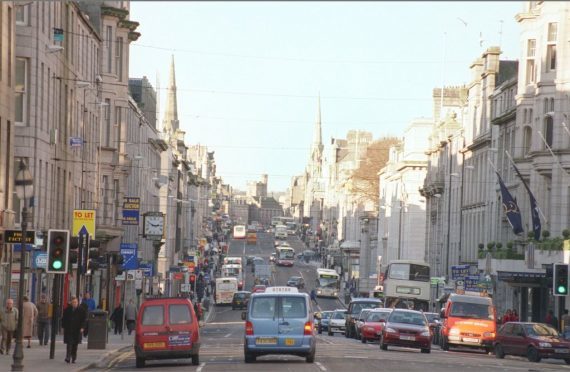Drivers’ groups have warned that introducing a car ban on some of Aberdeen’s most-polluted streets could “kill off” the city centre.
Councillors have ordered a study into whether gas-guzzling cars and lorries could be forced to pay to enter designated “low emission zones” – or even denied access altogether.
It is understood the scheme – which would be the first in Scotland -could cost as much as £10million.
Town House sources indicate that the streets included could be Union Street, Wellington Road and Market Street, all of which are suffer issues with poor air quality.
The idea enjoys cross party approval and Scottish environment secretary Roseanna Cunningham has also urged councils to implement the zones.
But last night angry drivers’ groups said the plan could “damage” city centre shopping, with shoppers taking their money to out of town centres with easy parking.
In January, a Friends of the Earth report revealed that Union Street, Wellington Road and King Street all rank among the most polluted in Scotland.
Earlier this month it was revealed that the city is also considered the third most congested in the UK according to a study by traffic information company Inrix
Aberdeen eclipsed even London for congestion at peak periods last year as the hardest city to get into or out of, with drivers stuck in gridlock 24% of the time, moving at an average of 5.5mph.
Low Emission Zones have been used in 200 European cities across 13 countries and can take a variety of forms, from restricting access for vehicles with high emissions to introducing tariffs based on emission levels.
Neil Greig, of the Institute of Advance Motorists, said: “If they don’t make it easy for people to get into the city centre then quite simply people will choose to go elsewhere.
“You have to target the worst pollution. But you also have to make sure you don’t damage the economy of the city.
“Heavy vehicles like lorries contribute a lot to the economy of Aberdeen and also city centre retail is needed.”
A spokesman for the Association of British Drivers said the plan was “plain daft”.
He said: “The irony is that councils are responsible for a lot of the congestion- they produce bus lanes and cycle lanes and restrict parking which holds up drivers.
“Local businesses die if you stop people having access to city centres. It is a sure way to kill off a city centre.”
Council transport spokesman Ross Grant said: “To date no Scottish city has introduced a low emission zone but as a local authority we have demonstrated our ability to innovate and are keen to lead the way if a strong business case can be demonstrated.
“We await the findings of officers but in principle it is clear low emission zones could be of great benefit to the city, where air quality has been an issue of concern despite a variety of positive moves to make improvements.”
Barney Crockett, who leads the city’s hydrogen transport project, said the public “wouldn’t believe” how quickly the city was going to change.
He said: “Firstly, this is at an early stage and it needn’t be assumed that the zones will be in the city centre.
“The key to the city centre will be parking and I’m sure that any business case prepared will take in the objectives of the city centre masterplan.
“For the most part Aberdeen’s streets are among the cleanest in Europe.
“But we have to look to the future, the speed of change in the city I think will really surprise people in the coming years.
“If you look to cities like London, Paris or New York- they are making rapid changes. Smaller cities like ours also need to lead on this.”
Officers have been instructed to report back to full council in June with their initial findings.
